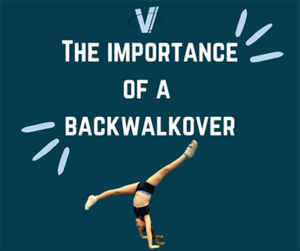 How many times have you heard a coach say “Your athlete needs to have a solid back walkover before he/she can start working on back handsprings”? The answer to that question should be a lot. Athletes often want to skip back walkovers and spring right into back handsprings. We’re here to help you understand the importance of back walkovers.
How many times have you heard a coach say “Your athlete needs to have a solid back walkover before he/she can start working on back handsprings”? The answer to that question should be a lot. Athletes often want to skip back walkovers and spring right into back handsprings. We’re here to help you understand the importance of back walkovers.
- Foundation for Advanced Skills: The back walkover is a fundamental skill that serves as a building block for more advanced tumbling moves. Mastering the back walkover helps athletes develop the strength, flexibility, and body control needed for these complex skills.
- Flexibility and Strength: Performing a back walkover requires significant flexibility, particularly in the shoulders, back, and legs. It also develops core strength and control, as athletes must engage their muscles to execute the move smoothly and safely.
- Body Awareness: The back walkover enhances body awareness. Athletes learn to understand their body’s position in space, which is crucial for performing precise and controlled movements in cheerleading routines.
- Confidence Building: Successfully performing a back walkover can boost an athlete’s confidence. Overcoming the fear of moving backward and trusting their body to perform the skill can be empowering and motivating.
- Routine Elements: In cheerleading routines, the back walkover adds aesthetic value and variety. It can be seamlessly integrated into sequences to enhance the visual appeal and difficulty level of the performance.
- Balance and Coordination: The back walkover requires balance and coordination to transition smoothly from standing to a bridge position and back to standing. Practicing this skill helps athletes improve their overall coordination and balance, which are essential for all aspects of cheerleading and gymnastics.
Overall, the back walkover is a versatile and essential skill that contributes to an athlete’s development in tumbling. It lays the groundwork for more advanced skills, enhances physical attributes, and adds value to performances.
